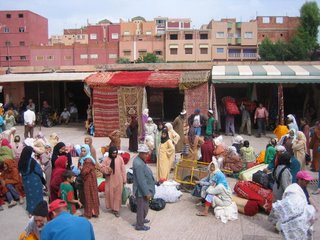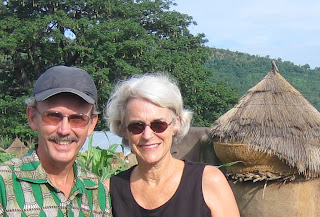It will soon be one year since we arrived in Togo, and we have just returned from a vacation to Morocco which has given us yet another perspective on life in Africa. Although Morocco is on the same continent, it felt like we left Africa since the culture and nearly all the people we saw there were Arab and/or Berber, both of whom came from the Middle East. Muslim is the predominant faith, and the dress is long robes for both men and women, with many covered female faces. Most Westerners visiting Morocco think it is quite poor, but from our West African perspective, it seemed quite developed. Gourmet meals, hot running water, reliable and comfortable travel, and fun shopping made us feel like we were living “high on the hog.”
As part of our Moroccan adventure, we stayed in “riads” - lovingly restored, beautiful and somewhat quirky centuries-old homes (narrow stairways, tiny doors, tranquil courtyards) inside the walls of the old cities. The cities themselves were amazing places to visit with lots of juxtaposition of new and old: Donkeys carry baskets on their backs for garbage pick-up while passing high tech internet cafes situated in a labyrinth of stone paved pathways not wide enough for cars. Women walk the family bread dough daily to the neighborhood baker to be baked in a wood-fired oven (just as has been done for centuries) while men talk on cell phones in front of their own shops. A motorbike pulls up to a butcher shop counter on the street (where un-refrigerated beef hangs on the hook) and the driver purchases the day’s meat, departing without dismounting. Wandering around the Djemaa el-Fna square amidst the snake charmers and acrobats, what rolls by but two tourists on Segway transporters, new fangled machines that look like overgrown lawnmowers we have only seen on TV newsreels & read about until now.
We spent our first day in the very cosmopolitan Casablanca visiting the 3rd largest mosque in the world and the only one open for touring to non-believers in Morocco. King Mohammed V built it in the 90’s in 6 years with local workers working around the clock, an impressive place on the ocean, holding 25,000 worshippers (with a retractable roof and huge titanium doors) costing over half a billion dollars. It was decorated by Moroccan artisans with geometric tile and wood carvings. (Muslims are not allowed to depict living things in their art). We enjoyed lunch at “Rick’s Café” where Wayne, in a Humphrey Bogart state-of-mind, sat at the piano and Cate asked him to “play it again, Sam.”
Fes, the “symbolic heart of Morocco” was the most cultured, artistic, religious and refined town we visited. It is 3 towns in one; ancient (as in medieval), old (13th century) and new (French colonial). We focused on the ancient walled city called the medina and needed a guide to show us around the incredible maze of over 9000 tiny, twisting alleys, narrow streets and blind turns. And what trip to Morocco would be complete without a rug purchase (so Cate said), so we succumbed and felt like we had the Moroccan equivalent of a timeshare condo sales pitch, leaving it feeling both remorseful and happy; remorseful about the price but happy with our choice. (The thorough sales pitch by our now best Moroccan friend who served us traditional mint tea during the presentation, included the fact we could resell the rug on eBay when we got back to the states and it would pay for our trip. That’s why we took his suggestion and ended up with more than one rug and are feeling a little sheepish…maybe from all the lamb we ate?). We also visited a large pottery shop to see pots, dishes and tiles being hand made and painted by boys and men. Then on to the tanneries where the foot stomping process of dying leather in small vats of vegetable dyes remains unchanged over the centuries. We also saw hand weaving of silk and cotton into beautiful cloth. The colors, crafts and goods of Morocco were a feast for our eyes, especially in relation to Togo where the economy is so bad creative arts suffer and mostly essential items are found in the shops.


The next day we visited Volubilis, a Roman ruins site dating from the 2nd and 3rd centuries and one of the most remote Roman outposts. The high point was the stunning mosaic floors left in their original locations, now exposed to the elements, that were walked on 1900 years ago. Then we visited the small neighboring town of Mouley Idress where a leader of the same name founded the country’s first dynasty in the 8th century after he was driven out of Mecca by rival Muslims, bringing Islam to Morocco. It is a picturesque, white walled city situated on a hill surrounded by lush vegetation.
We then traveled south through the Atlas mountains in a taxi where stops included a visit with free-roaming monkeys in the wild, a very animated poor village rug market and an elitist ski resort village. After a night in a small, dusty, dry mountain town we downgraded to local bus service to get to Essaouira, an ancient beach town known for its 18th century ramparts and movie making by Orson Wells. Our guest house was inside the old town looking down on the rocky Atlantic coastline just outside the walls. Fortunately Essaouira is much smaller than Fes and we were able to find our own way around the medina. Now it is mostly a fishing port and tourist destination for Europeans. We had a great lunch on the dock with our own hand selected fish grilled in front of us. As Americans we were quite unique. We tried to use our French (Morocco being a French-speaking country), but they would almost always gleefully answer us in halted English. I guess our accent is a dead give-away. We especially enjoyed the Mediterranean climate. It was the first time since our arrival in Togo that we have used our Seattle fleece jackets. We knew we brought them for a reason!
Our last city was Marrakesh where another old restored city mansion gave us much needed respite from the hustle and bustle of the city. Marrakesh, founded in 1062, has a walled medina (old town) which includes a large plaza pretty much dedicated to the tourist, both Western and Moroccan. Restaurants surround the big plaza in which they promote the medieval myth and mystery of Marrakesh with snake charmers, story tellers, acrobats, musicians, jugglers and henna artists. The aroma of grilled meats and fresh squeezed oranges permeate the area and located nearby is the myriad of “souqs” (small markets) which sell every handicraft made in Morocco and include tiny meat markets, hardware stores and motorbike repair shops.


We went to Morocco with high expectations and happily we were not disappointed. Returning “home” to Togo, however, was surprisingly nice, especially the feeling of it being “home.” Our community of friends missed us and gave us a warm welcome back (did they think we might not return?). We appreciate even more now the evident joy of life here, shown in the way people talk, laugh, dress and move to whatever rhythm they might be hearing. We realize we have developed a comfort level with some of the quirkier facts of life here. Our mid-Eastern experience in Morocco gave us a stronger appreciation for the essence of Africa and we’re glad we’re here in Togo. For family and friends, however, don’t worry about us extending our time (as some volunteers do). We are also looking forward to the perspective we will have upon returning to the US.




